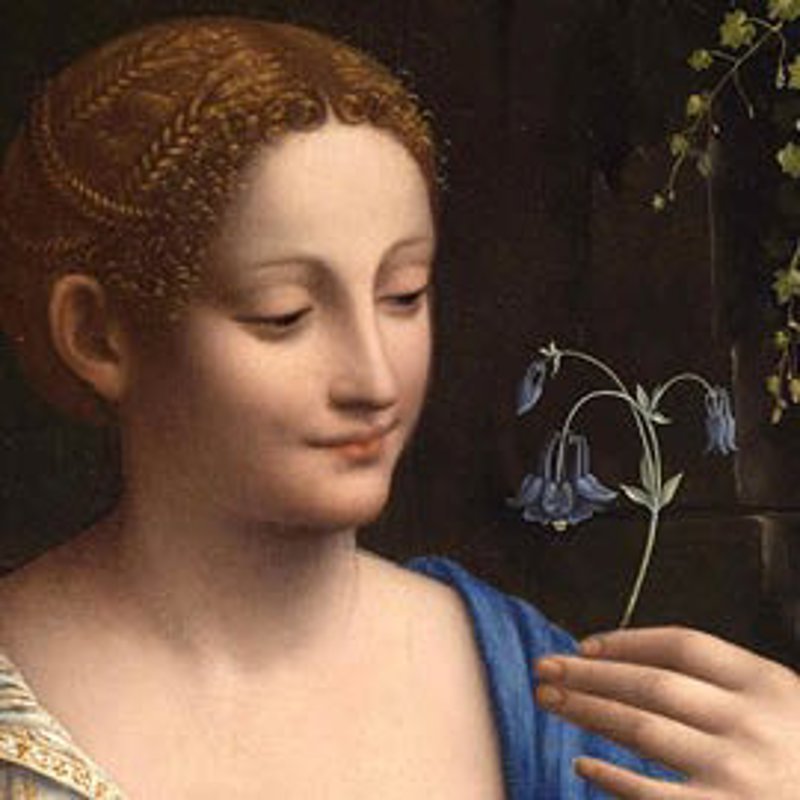
Leonardo’s Legacy
Francesco Melzi and the Leonardeschi
To mark the 500th anniversary of Leonardo’s death in 2019, 'Leonardo’s Legacy: Francesco Melzi and the Leonardeschi' celebrated the work of Leonardo’s followers, the ‘Leonardeschi’. At its heart was Melzi’s 'Flora', an exceptional loan from the State Hermitage Museum, St Petersburg, which had recently undergone restoration.
The National Gallery does not own a painting by Melzi, so the display gave the opportunity to view a picture by this important artist alongside nine key works by other Leonardeschi. It was the first time 'Flora' had been exhibited in the UK, and the first time it had been seen outside of Russia since its restoration.
Who was Melzi?
Francesco Melzi (1493–1570) was born into a noble family in Milan. He became Leonardo’s favoured pupil after joining his Milanese workshop in around 1508. Melzi worked for Leonardo in Rome, and followed him to France, where he stayed until Leonardo’s death in 1519.
It is largely due to Melzi’s efforts that Leonardo’s notebooks and drawings have survived. Leonardo left ‘each and every one’ of his notebooks to Melzi, who took them back to Milan. The artist and biographer, Giorgio Vasari (1511–1574), visited Melzi in his old age, and reported that Leonardo’s ‘much beloved’ pupil had inherited his late master’s anatomical designs: ‘he holds them dear, and keeps such papers together as if they were relics’.
Melzi’s 'Flora' is so close to the style of his teacher that for many years it was thought to be by Leonardo himself. The female facial type with its downcast look is characteristic of Leonardo, and comparable to the face of the Virgin in The Virgin of the Rocks and The Burlington House Cartoon (both on display in Room 66). Melzi also uses Leonardo’s ‘sfumato’ technique of blurred outlines to model forms, while the depiction of the plants and Flora’s complicated hairstyle shows his understanding of Leonardo’s scientific discoveries.
After being acquired by the Hermitage as a Leonardo in 1850, the picture has since been attributed to other prominent Leonardeschi – Bernardino Luini, Andrea Solario and Giampietrino – before finally settling on Melzi in 1899. Few works by Melzi are known: only two works signed by him have survived (both in Milan), and a few others are attributed to him, including a chalk portrait of Leonardo in the Royal Collection Trust. The attribution of 'Flora' to Melzi is based on the painting’s close similarities to another work which has been attributed to the artist: 'Vertumnus and Pomona', at the Gemäldegalerie in Berlin (see image below). The attribution is also supported by the 18th-century art connoisseur Pierre-Jean Mariette’s record of a painting depicting Flora by Melzi in Paris which had been mistaken by at least one other scholar as a work by Leonardo himself.
Learn more about 'Flora'
Melzi's painting depicts Flora, the Roman goddess of springtime and flowers, seated in a leafy grotto sprouting with fern and ivy. Her exposed breast and her close inspection of a sprig of aquilegia – a symbol of fertility – emphasise her role as ‘mother of flowers’ ('Mater Florium'). Before the identification of Flora was made, the picture was best known by the title ‘La Colombina’, or ‘Columbine’, after its most prominent flower, aquilegia, another name for which is columbine. Other names that have been ascribed to it in the past include ‘Vanity’, ‘Gioconda’ and ‘Portrait of Mme Babou de la Bourdaisière’ (the mistress of Francis I).
Recent restoration undertaken by the State Hermitage Museum has revealed the picture’s true colours, notably the powerful ultramarine blue of her cloak. Hidden details have also been revealed, including delicate flowers growing from the walls of the dimly lit grotto. Infrared reflectography has also demonstrated that Melzi ensured anatomical correctness by mapping out Flora’s naked figure before painting her clothing.
Learn what the flowers in the painting symbolise:
The Leonardeschi
Leonardo’s scientific discoveries and inventions were not given due recognition for centuries, but his painting style made an immediate impact on artists. The term ‘Leonardeschi’ has since been coined to identify painters in or near Milan who were taught by or associated with Leonardo, or whose work bears his influence.
The display at the Gallery features works by Giovanni Antonio Boltraffio (about 1467–1516), Marco d’Oggiono (active from 1487–died 1524), Giampietrino (active about 1500–1550), Bernardino Luini (about 1480–1532), and Martino Piazza (active about 1513–1522), among others.
In his painting, Leonardo pioneered the combination of detailed naturalism and ‘divine grace’, with which he sought to surpass the beauty of nature. His followers absorbed different characteristics of their master’s art, in particular his elegant compositions, meticulous rendering of plants, hair and dreamlike landscapes, and the blurred outlines he used to model forms, known as ‘sfumato’. In Leonardo’s words: ‘The true outlines of opaque bodies are never seen with sharp precision’.
Click on the images below to see some of the works in the display:
Find out more
Watch our Vivmar Curatorial Fellow, Emily Burns, introduce the display in a Facebook Live on 29 May at 6.15pm.
A booklet about the restoration of the painting, 'Flora Restored' by Tatiana Kustodieva (State Hermitage Museum, 2019), can be purchased in the National Gallery Shop.













